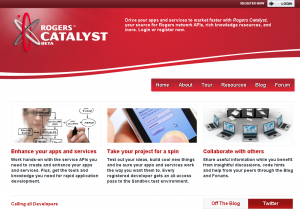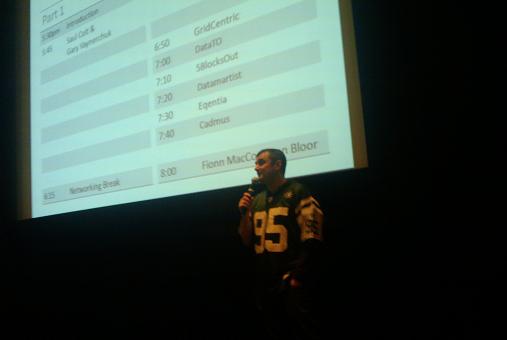
Last night marked amazingly the 29th event of Toronto’s increasingly supernumerative DemoCamp scene. To warm up the crowd we had a little help from legendary Canadian investor and the man with a few more twitter followers than you, @howardlindzon. In case you didn’t make it, here’s my notes for you, of varying coherency, of the course of the evening.
- The job of entrepreneurs is to get in the way of trends. You don’t need to predict the future you just need to get in the way of trends. The larger and longer the trend the better. Lindzon is not a value investor, he’s a momentum and sentiment investor.
Lindzon started his company through social leverage. But it didn’t come over night, he met Fred Wilson over the course of a year and becoming friends before starting Wallstrip which they sold to CBS. And gained some more cred. But once you sell your company you lose control of your vision. Then he passed on Twitter at 20M valuation. You don’t always catch the winner. You make mistakes. But he could see when he was wrong so he was, by force of will, able to get into Tweetdeck, Bit.ly and others, the idea was to put himself in the way of the trend. I didn’t understand Twitter but I knew it was a trend and was able to buy everything around Twitter. You have to use social leverage to find investors that understand your domain and understand your passion.
Raising money is an art. We’re in a great environment to raise money but that doesn’t entitle you. You have to have a great angle of attack against your competitors, you have to be great at telling your story. You have to explain the benefits of the product not the features.
Dashboards, I want to get my life down to as few screens as possible. Also I read Hackernews and TechMeme in order to understand the sentiment of my industry.
On to the Demos:
500 pixels – Oleg Gutsol @500px
There are many picture websites like it, but this one is ours. Very pretty pictures. We promote the best pictures in the world. Recently closed funding, getting some media buzz. Also a premium themed galleries for photographers. What we nailed was not just the product but the community. Something that they doing better than Flickr “Flickr has become a dump site” 500px is an art site.
TitanFile
Sending secure files, slick interface. Common demo gods, Soo… “lets assume that you received the email…”. No, wait it’s there, to the adulation of the crowd, stupid Gmail delay. You send an notification email and then it also calls you to IVR read you a passcode. Then everything is tracked. Wants to thank Assange for helping to push their business forward. Accountants, lawyers anyone who needs to make sure their documents get there every single time. And delivery receipt is an added value.
High Score House – turn household chores into a game for your kids
Great playful signup screen that sets the tone. Brilliant super obvious reminders and rewards for doing stuff like making a bookmark and remembering your PIN. App awards virtual currency (stars) that parents can set the price for like what the value of helping to make dinner and what points are worth for tv time or a new toy. The Ah Ha! moment is when kids are running up the stairs to do clean their room. Also great for kindness points, what have you done that’s kind today? Cool! You rock! You earned it! This app really rocks and has so much character. App works great on the ipad. Beta testing is spending just a tiny bit of money a day on facebook to bring on 10 moms at a time. Key dashboard metric number of exclamation points in emails from moms. Lookout ClubPenguin, with a little work, High Score House could will be the next big exit that gets Canada to a billion dollar year. Judging by Twitter response, High Score House wins Democamp this round.
Money quotes: we’ve got moms all over loving us, but like, in the acceptable way
Top question: Can you make a version that works on spouses? [I don’t know, but in our household we’re already debating who’d the “parent” side of the account…]
Vizualize.me – is a startup that won startup weekend. It’s a 5 day old startup.
Problem is how do you display yourself in a different way than a resume. It’s an infographic that scrapes your linkedin profile and makes really pretty graphs. Sign-up rate they just hi 12 thousand users 5 days after launching the company… [holy crap] Product itself is nicely viral because you post your infographic to twitter or facebook or linked and other people see it and feel compelled to create their own. Feemium businessmodel. We want to be the site you go to brand yourself visually and socially. Could easily expand into other personal visual branding applications… but that can wait at least until next week.
WeAreTOTech – A new community service launched by @Michele_Perras, @LeilaBoujnane & @AprilDunford
A Toronto-based Directory that will profile, showcase, promote and connect profiles of local tech heros in Toronto, to help you make connections, to help you find advisors, mentors and conference speakers. Inspired by WeAreTechNY and “in the hopes of connecting everyone, shining a spotlight on developers, CEOs and founders, executive, hackers who make our tech community what it is, we decided to give you We Are TO Tech.” This is a fantastic idea, and what they need right now is you if you fit the description to fill out this form here.
Xtremelabs – Alpha Slides demoed by James Woods
Remove some of the failings of presentations, by making a simple mobile app that broadcasts slide decks to everyone in your audience’s devices simultaneously. Works in a coffee shop, boardroom or conference. Alpha Slides is in the App Store now. I can cast a mini slide deck from one mobile device to another. When I slide a slide it slides on your slide too. Cross platform is the key (apple now has mobile keynote for iphone but only does iphones). Business model is to sell app space, and freemium features. You can follow a conference when not at a conference or I can follow a conference when I’m at one even if I can’t get close to the screen and take it with me when I’m done. A company like Dell could have their own secure instance if they want to as an internal meeting tool. App has potential, could see this taking off in the enterprise as well as the personal or conference usage.
That’s it folks. Awesome caliber of demos again this round. We’re now looking forward to the big DemoCampTO 3-oh. You know what they say, thirty is flirty.
Further reading: @Sachac’s nifty sketchnotes of DemoCamp Toronto 29



